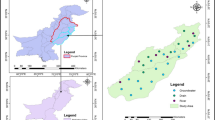Abstract
Chemical analyses of 21 water samples from the Firehole and Gibbon Rivers, which combine to form the Madison River, gave arsenic and fluoride values above the Environmental Protection Agency Interim Primary Drinking Water maximum contaminant levels (0.05 mg/l arsenic and 2.0 mg/l fluoride). On 18 October, 1975, during a period of moderate flow (16,600 l/s), the Madison River at West Yellowstone contained 0.23 mg/l arsenic and 6.2 mg/l fluoride. Below Hebgen Lake the Madison River during periods of high flow (56,000 liter/s at West Yellowstone and 708,000 liter/s below Hebgen Lake) would contain 0.05 mg/l arsenic at both stations and 1.5 and 4.0 mg/l fluoride at West Yellowstone and below Hebgen Lake, respectively. The strong correlations of arsenic and fluoride with other chemical constituents of the river water at the sampling sites demonstrate the conservative nature of each element after it reaches the Madison River system. Calculations indicate that water from three sampling sites is above saturation with respect to fluorite.
Similar content being viewed by others
References Cited
Allen, E. T., and A. L. Day. 1935. Hot springs of the Yellowston National Park: Washington, D.C., Carnegie Institution of Washington Publication 466, 525 pp.
Bargar, E. E., M. H. Beeson, R. O. Fournier, and L. J. P Muffler 1973. Present day deposition of lepidolite from thermal water in Yellowstone National Park: Amer. Mineral., v. 58, p. 901–904.
Brown, D. W., and C. E. Roberson. 1977. Solubility of fluorite at 25°C: Jour. Res. U.S. Geological Survey, v. 5, n. 4, p. 509–517.
Brown, E., M. W. Skougstad, and M. D. Fishman. 1970. Method for collection and analysis of water samples for dissolved and gases: U.S. Geological Survey Techniques of Water Resources Investigations, Book 5, Chapter A1, 160 p.
Cox, E. R. 1973. Water resources of Yellowstone National Park Wyoming, Montana, and Idaho: U.S. Geological Survey Open File Rept., 161 p.
—— 1975. Discharge, measurement, and chemical analyses of water in northwestern Wyoming: Wyoming Water Planning Program Report No. 14, State Engineer's Office, Cheyenne Wyoming, 21 p.
Environmental Protection Agency. 1972. Yellowstone National Park baseline water quality survey: Environmental Protection Agency, Denver, Colorado, Region VIII Report for May–September, 1970, 194 p.
—— 1975. National interim primary drinking water regulations: Water programs part IV: Federal Register, v. 40, n. 248. Wednesday, 24 December 1975, p. 59570.
Fournier, R. O., and A. H. Truesdell. 1974. Geochemical indicators of subsurface temperature—Part 2, estimation of temperature and fraction of hot water mixed with cold water: Jour. Res. U.S. Geological Survey, v. 2, n. 3, p. 263–269.
——, D. E. White, and A. H. Truesdell. 1976. Convective heat flow in Yellowstone National Park:In Proceedings, Second United Nations Symposium on the Development and Use of Geothermal Resources, San Francisco, California, 1975, v. 1: U.S. Government Printing Office, Washington, D.C., p. 731–739.
Gooch, F. A., and J. E. Whitfield. 1888. Analyses of waters of the Yellowstone National Park: U.S. Geological Survey Bull. 47, 84 p.
Hem, J. D. 1970. Study and interpretation of the chemical characteristic of natural water: U.S. Geological Survey Water Supply Paper 1473, 2d ed., 363 p.
Keenan, J. H., F. G. Keyes, P. G. Hill, and J. G. Moore. 1969. Steam Tables (International Edition): New York, John Wiley and Sons, p. 2–7.
Keith, T. E. C. and L. J. P. Muffler. 1978. Minerals produced during cooling and hydrothermal alteration of ash flow tuff from Yellowstone drill hole Y-5: Jour. Volcanol. Geotherm. Res., v. 3, p. 373–402.
Noguchi, K., and J. Nix. 1973. Geochemical studies of some geysers in Yellowstone National Park: Japan Acad. Proc., v. 39, p.370–375.
Rowe, J. J., R. O. Fournier, and G. W. Morey. 1973. Chemical analyses of thermal waters in Yellowstone National Park, Wyoming, 1960–1965: U.S. Geological Survey Bull. 1303, 31 p.
Scott, R. C. 1964. Records in postearthquake quality of groundwater:In The Hebgen Lake, Montana, earthquake of August 17, 1959: U.S. Geological Survey Professional Paper 435, p. 179–184.
Shapiro, L., and W. W. Brannock. 1956. Rapid analysis of silicate rocks: U.S. Geological Survey Bull. 1036C, 56 p.
Sillen, L. G., and A. Martel. 1964. Stability constants of metal ion complexes: The Chemical Society (London), Spec. Publ. No. 17, 2d ed., 754 p.
Stauffer, R. E. 1978. Molybdenum-blue methodology applied to arsenic and phosphorus analyses of geothermal waters: Jour. Res. U.S. Geological Survey, in press.
--, and J. M. Thompson. 1976. Arsenic and antimony in geothermal waters of Yellowstone National Park (abstract): Program (Abstract), First Conference of Scientific Research in the National Parks, sponsored by AIBS and National Park Service, p. 83.
Thompson, J. M. 1975. Selecting and collecting thermal springs for chemical analysis: A method for field personnel: U.S. Geological Survey Open-File Rept. 75–68, 12 p.
--, T. S. Presser, R. B. Barnes, and D. B Bird. 1975. Chemical analyses of the waters of Yellowstone National Park, Wyoming, 1966–1973: U.S. Geological Survey Open-File Rept. 75-25, 59 p.
--, and Sandhya Yadav. 1979. Chemical analipes of water from geysers, hot springs and pools in Yellowstone National Park, Wyoming from 1974 to 1978: U.S. Geological Survey Open File Rept. 79–704, 49 p.
U.S. Geological Survey. 1974. Surface water supply of the United States 1966–70: U.S. Geological Survey Water Supply Paper 2116, Part 6, Missouri River Basin, v. 1, Missouri River Basin above Williston, North Dakota, p. 71–79.
Author information
Authors and Affiliations
Rights and permissions
About this article
Cite this article
Thompson, J.M. Arsenic and fluoride in the upper madison river system: Firehole and gibbon rivers and their tributaries, yellowstone national park, wyoming, and southeast montana. Geo 3, 13–21 (1979). https://doi.org/10.1007/BF02423274
Issue Date:
DOI: https://doi.org/10.1007/BF02423274




